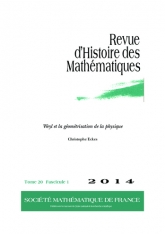Weyl et la géométrisation de la physique
Weyl and geometrization of physics

- Consulter un extrait
- Année : 2014
- Fascicule : 1
- Tome : 20
- Format : Électronique
- Langue de l'ouvrage :
Français - Class. Math. : 01A60, 03A05, 53A30, 53B50.
- Pages : 95-170
- DOI : 10.24033/rhm.180
Dans cet article, nous entendons décrire les rapports entre géométrie et physique dans l'œuvre de Weyl entre la fin des années 1910 et le début des années 1930. À cette fin, nous montrerons tout d'abord que Weyl s'intéresse aux théories relativistes à partir de 1916 via différents protagonistes : Grossmann, Einstein ou encore Hilbert. Minkowski est également une source d'inspiration pour Weyl. Ce dernier est alors convaincu qu'il existe une harmonie préétablie entre les développements de la physique et de la géométrie, illustrée par sa première théorie de jauge. Ensuite, nous souhaitons repérer les points communs, mais aussi les nombreuses divergences entre Hilbert et Weyl en physique mathématique d'un point de vue tant scientifique que philosophique en 1915–1921. Enfin, au cours de la seconde moitié des années 1920, Weyl s'intéresse à la mathématisation de la mécanique quantique et il développe une seconde théorie de jauge. Son épistémologie se caractérise par un tournant empirique. De plus, il est amené à relativiser l'importance de la géométrie (riemannienne et différentielle) pour mathématiser la physique. Il critique par ailleurs frontalement le projet de théorie unitaire fondée sur la notion de parallélisme absolu développé par Einstein.
Weyl, Hilbert, Einstein, relativité générale, variétés de Weyl, théories unitaires, théories de jauge.

